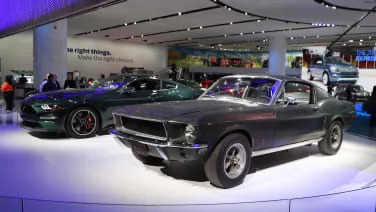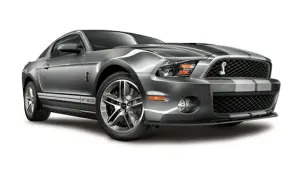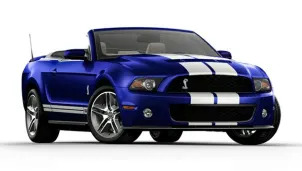2010 Ford Shelby GT500
2010 Ford Shelby GT500 – Click above for high-res image gallery The four pillars of Ford's SVT division are Performance, Exclusivity, Substance and Value. No one is expecting the 2010 Shelby GT500 to have any problem with the last three – it's the first one that means everything. Ford told us the five tenets of the new car all start with the word "better" and end with horsepower, torque, handling, interior and fuel economy. Sent to Northern California for two days to drive it, we had only one question – whether all of those other "betters" truly equated to substantially improved performance than the previous car. The first day covered miles and miles of oceanside and backcountry roads. The second day covered figure-eights, the drag strip and the road course at Sonoma's Infineon Raceway. Follow the jump to see how the latest fanged horse does its thing. %Gallery-49278% Photos copyright ©2009 Drew Phillips / Weblogs, Inc Skipping ahead a bit, we were told that the point of the GT500 is to be a great GT. When SVT began working on the car, they took the previous GT500 as one of their obvious standards. They were also thinking about the muscle car competition that they expected – 2.5 years ago Ford planned on a factory-built 500+ horsepower supercharged Chevrolet Camaro and Dodge Challenger as competition. So Ford went the extra quarter-mile on its car, figuring the others would have the 2010 GT500 as their benchmark. The polestar of the GT500 is the supercharged and intercooled 5.4-liter V8. This eight-chambered heart with dual overhead cams puts out 540 hp (at 6,200 rpm) and 510 ft-lb (at 4,500 rpm) with a 6,250 rpm redline. That gives it 40 more Shetlands and 30 additional foot-pounds than the previous model, with the additional torque delivery coming in at 3,000 rpm. No delay is always a good thing. The engine was then tweaked using another benchmark: the 40th anniversary Shelby GT500KR. The GT500 gets the KR's cold-air induction system with an open-air conical filter element and snorkel lying on the right side of the engine bay (that's why the Cobra badge had to move to the left side of the grille). The open-air system increases airflow, and a sealed enclosure keeps the air going where it should. The package also benefits from revised calibration with a dual-knock sensor, revised throttle and an intake resonator to reduce noise. Yet what good would all that function do without the proper form? How do we christen thee "Badass"? Let us count the ways. The KR was also the inspiration for the aero modifications to the GT500, all designed to look good as well as add downforce and subtract drag. Up front, the arctic crevasses posing as air intakes were referred to as "shark nose" by Ford – we'd go with "exceptionally evil catfish." At the top of that bisected mouth, air is routed to the radiator, which is sealed to keep said turbulence flowing to the right places. …
Full Review
2010 Ford Shelby GT500 – Click above for high-res image gallery The four pillars of Ford's SVT division are Performance, Exclusivity, Substance and Value. No one is expecting the 2010 Shelby GT500 to have any problem with the last three – it's the first one that means everything. Ford told us the five tenets of the new car all start with the word "better" and end with horsepower, torque, handling, interior and fuel economy. Sent to Northern California for two days to drive it, we had only one question – whether all of those other "betters" truly equated to substantially improved performance than the previous car. The first day covered miles and miles of oceanside and backcountry roads. The second day covered figure-eights, the drag strip and the road course at Sonoma's Infineon Raceway. Follow the jump to see how the latest fanged horse does its thing. %Gallery-49278% Photos copyright ©2009 Drew Phillips / Weblogs, Inc Skipping ahead a bit, we were told that the point of the GT500 is to be a great GT. When SVT began working on the car, they took the previous GT500 as one of their obvious standards. They were also thinking about the muscle car competition that they expected – 2.5 years ago Ford planned on a factory-built 500+ horsepower supercharged Chevrolet Camaro and Dodge Challenger as competition. So Ford went the extra quarter-mile on its car, figuring the others would have the 2010 GT500 as their benchmark. The polestar of the GT500 is the supercharged and intercooled 5.4-liter V8. This eight-chambered heart with dual overhead cams puts out 540 hp (at 6,200 rpm) and 510 ft-lb (at 4,500 rpm) with a 6,250 rpm redline. That gives it 40 more Shetlands and 30 additional foot-pounds than the previous model, with the additional torque delivery coming in at 3,000 rpm. No delay is always a good thing. The engine was then tweaked using another benchmark: the 40th anniversary Shelby GT500KR. The GT500 gets the KR's cold-air induction system with an open-air conical filter element and snorkel lying on the right side of the engine bay (that's why the Cobra badge had to move to the left side of the grille). The open-air system increases airflow, and a sealed enclosure keeps the air going where it should. The package also benefits from revised calibration with a dual-knock sensor, revised throttle and an intake resonator to reduce noise. Yet what good would all that function do without the proper form? How do we christen thee "Badass"? Let us count the ways. The KR was also the inspiration for the aero modifications to the GT500, all designed to look good as well as add downforce and subtract drag. Up front, the arctic crevasses posing as air intakes were referred to as "shark nose" by Ford – we'd go with "exceptionally evil catfish." At the top of that bisected mouth, air is routed to the radiator, which is sealed to keep said turbulence flowing to the right places. …
Hide Full Review
Hide Full Review
Retail Price
$46,725 - $51,725
MSRP / Window Sticker Price
| Engine | 5.4L V-8 |
| MPG | Up to 14 city / 22 highway |
| Seating | 4 Passengers |
| Transmission | 6-spd man w/OD |
| Power | 540 @ 6000 rpm |
| Drivetrain | rear-wheel |
| Curb Weight | 3,920 - 4,040 lbs |
Smart Buy Program is powered by 






